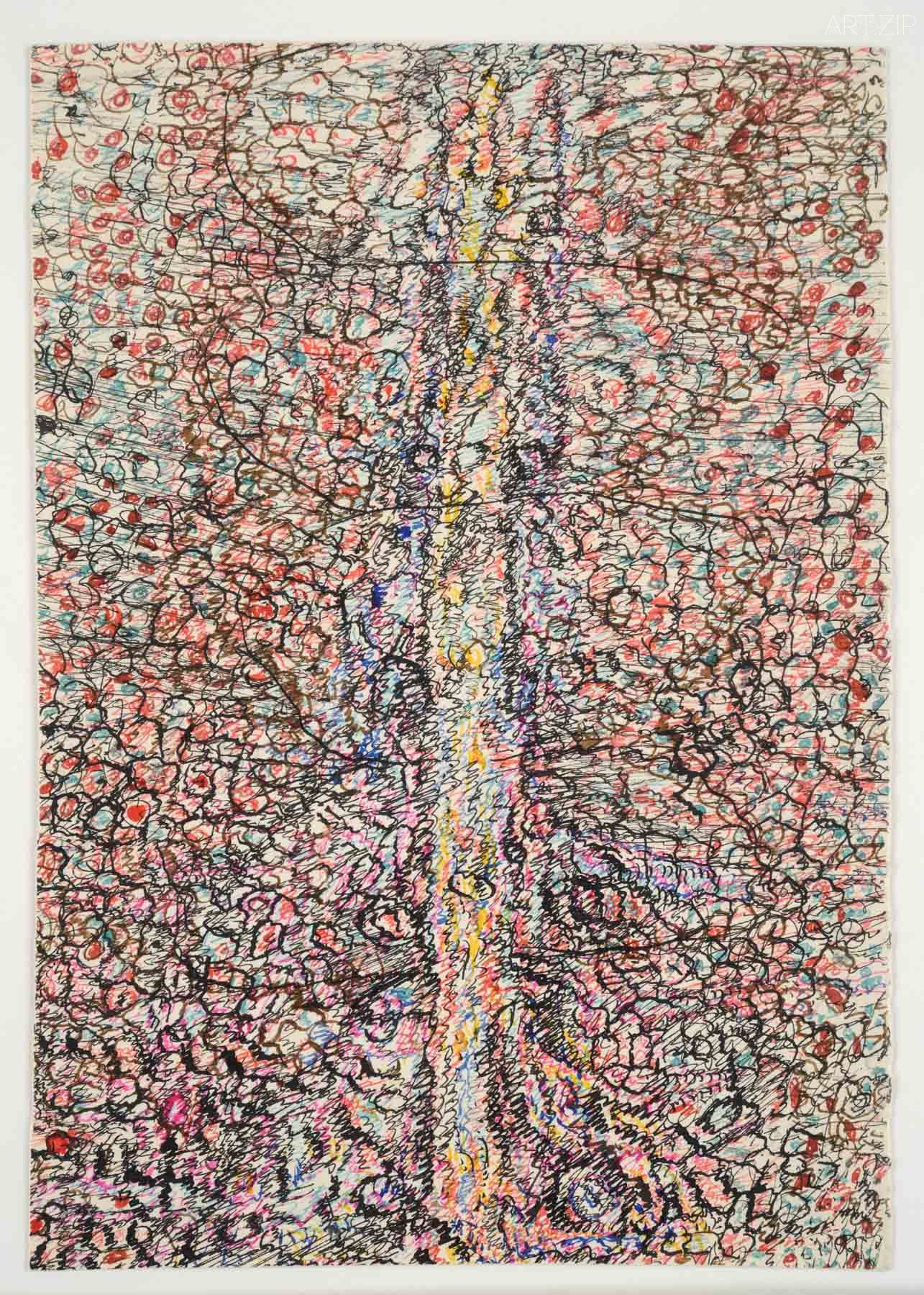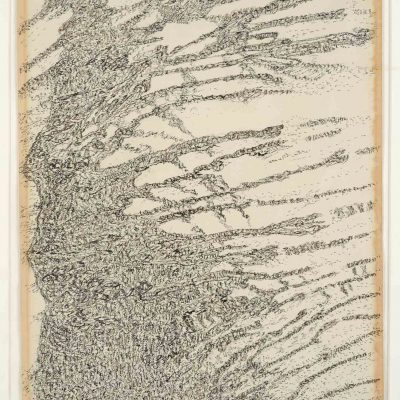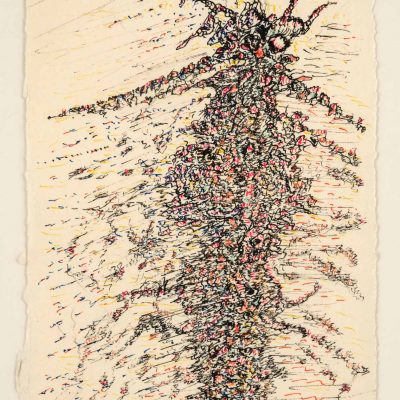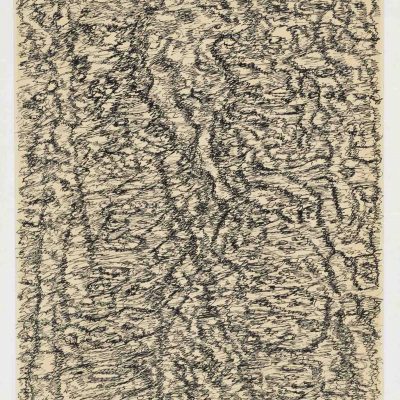
12th February – 4th June 2025
The Courtauld Gallery

Henri Michaux by Claude Cahun – Paris, France, 1925
This portrait of Henri Michaux (1925) by Claude Cahun, portrays him as his own double. It is an image that draws him into the orbit of Surrealist encounter with connotations of hauntology, de-centred subjectivity, and estranged otherness. Perhaps the double also serves to confirm a relationship to the uncanny in which things are never as they first appear. To have embarked upon a journey into the psychological interior through ingesting mescaline to make an inscriptive recording of it, is testament to a desire to test the limits of human experience. Part of this limit experience is the question of who or what is enacting the drawing process. This question is aimed towards an attempt to understand the way the etheric body functions to regulate the relationship between the body and the energetic forces external to it.
As a poet and writer, the identity of his experiments with drawing still retains a close relationship to writing, as if in part, there is a common origin for each of the practices. The closest influence on his work was with Far Eastern calligraphy and between 1930 to 1931 he travelled extensively in India, China, and Japan to better understand the cultural difference informing the cultures of East and West and in particular Buddhism. One of the effects of Mescaline and LSD is to experience a curvature within the space-time continuum and this sense is regulated by the pineal gland that is the size of a pea, but when stimulated, it can serve to alter experience of reality in profound ways. For this reason, it became known as the mystical gland or third eye in esoteric literature.
From his accounts of the process of taking drugs, he submitted the various processes as if it was a scientific experiment which then in turn could be described as adhering to methodical procedures. A meeting points of aesthetic, mystical, and scientific experiment then becomes understandable as a possibility which otherwise would be open to arbitrary speculation. The drawing themselves are intensifications drawn out of the networks of the nervous system, inventing with this passage of interiority. It is as though each mark or abstract figures is dancing on clusters of nerve endings. The field that is formed assumes a life as its own and as such discharges itself as a pulsing and vibratory field formed out a contracting and expanding mass. They evoke a world, but one remote from any known world. It invites passage into an immersive terrain that links mind and matter by presenting evidence for such a deduction. On an immediate level the practice links to the European movement of Tachisme and Beat culture especially in their respective connections to Far Eastern art, poetry, and philosophy. This framework links Romanticism, Symbolism, and Surrealism into a counter rhythmical expressive force field which became party to structured, as well as casual employment of drug induced experience. Experiments that related to the expansion of the mind were in turn readily linked aesthetic innovation and intuition. Michaux was a cult figure within the margins of sixties Counterculture, both because of his literary contribution (extreme literature), and his graphical production related to psychedelics. On a literary level, he forms a potent link between figures such as Georges Bataille and Antonin Artuad, and with this, the notion of culture absorbing the dark, transgressive margins of aesthetic presentation. This exhibition should serve to draw Michaux into the broader reconfiguration of drawing practice, which has become so evident in recent attention to it.

Henri Michaux (1899-1984), Untitled, 1956, Graphite, black and coloured inks on paper, 184 x 131mm. Private collection c. ADAGP, Paris and DACS, London 2025
克勞德·卡翁(Claude Cahun)於1925年創作的這幅昂利·米肖(Henri Michaux)肖像,將他呈現為自身的「分身」。這一形象將米肖带入超現實主義的相遇之境,并融入幽靈存在(hauntology)、去中心化主體性與異化他者的内涵。或許,這一「分身」也揭示了某種與「詭異感」(uncanny)相關的聯繫——事物的表象永遠無法還原其本質。米肖通過服用麥司卡林(mescaline)以深入心理內部世界,並試圖記錄這一體驗,此舉本身便展現出他對人類經驗極限的探索慾望。而這種極限體驗的一部分,便是對「是誰或是什麼在進行創作」這一問題的思考。這一追問進一步指向對「以太體」(etheric body)如何調節肉體與外部能量關係的探尋。
作為詩人和作家,米肖的繪畫實驗依然與寫作保持著緊密的聯繫,彷彿這兩種實踐在某種程度上源於同一個起點。他的作品最直接的影響來源於遠東書法。1930年至1931年間,他廣泛遊歷印度、中國和日本,試圖更深入地理解東西方文化背後的差異,尤其是佛教的影響。麥司卡林(Mescaline)和LSD的一大效應,是讓人感受到時空的彎曲,而這一體驗受松果體(pineal gland)調節。儘管松果體僅有豌豆大小,但在受到刺激時卻能極大地改變人對現實的感知。因此,在神秘學文獻中,它被稱為「靈性腺體」或「第三隻眼」。
從他對服用致幻劑過程的記錄來看,他將這一經歷呈現得如同一場科學實驗,遵循嚴格的系統化方法。因此,審美、神秘體驗與科學實驗在此交匯,不再僅僅停留於主觀臆測,而是構築了一種可供理解的可能性。他的繪畫可被視為神經系統網絡激發的「強化顯現」,通過這一內在通道展開創造。每一道線條、每一個抽象形態,彷彿都在神經末梢的簇群上舞動。畫面似乎擁有獨立的生命,以一種收縮與膨脹交替的動態形式釋放自身,最終形成一個脈動且振動的場域。它們喚起一個世界,卻遠離任何已知現實。這些圖像引導觀者步入沈浸式空間,在其中,視覺語言與精神體驗相互滲透,進而印證心智與物質的潛在關聯。 在直觀層面上,米肖的創作實踐與歐洲的塔希主義(Tachisme)運動及「垮掉的一代」(Beat Generation)文化相呼應,尤其體現在它們與遠東藝術、詩歌及哲學的聯繫上。這一框架將浪漫主義、象徵主義和超現實主義交織在一起,形成一種反節奏的表現力場域。它既關聯結構化的藝術實踐,也滲透到即興的致幻體驗之中。圍繞意識擴展的實驗自然而然地與審美創新和直覺融合。米肖被視為六十年代反文化運動中的邊緣偶像,這既源於他在極端文學上的貢獻,也來自他與迷幻體驗相關的視覺創作。在文學層面,他成為連接喬治·巴塔耶(Georges Bataille)和安托南·阿爾托(Antonin Artaud)等人的關鍵紐帶,並進一步揭示了文化如何吸納審美表現中的黑暗與越界元素。本次展覽意在將米肖納入當代繪畫實踐的更廣泛重構之中,而這一趨勢近年來已愈發受到關注。

Installation view, Henri Michaux. Mescaline Drawings, The Courtauld Gallery. © Fergus Carmichael
Text by Jonathan Miles
Edited by Michelle Yu




